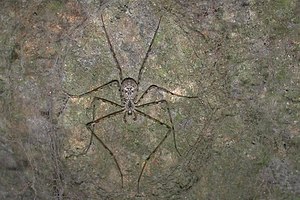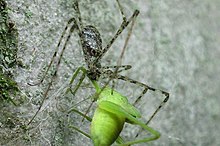Hypochilidae
| Hypochilidae | ||||||||||||
|---|---|---|---|---|---|---|---|---|---|---|---|---|

|
||||||||||||
| Systematics | ||||||||||||
|
||||||||||||
| Scientific name of the superfamily | ||||||||||||
| Hypochiloid | ||||||||||||
| Marx , 1888 | ||||||||||||
| Scientific name of the family | ||||||||||||
| Hypochilidae | ||||||||||||
| Marx , 1888 |
The Hypochilidae are a family of true spiders that includes two genera with a total of 12 species . An older synonym for the family is also Ectatostictidae. With their very long legs and small bodies, they can easily be mistaken for trembling spiders . Like this one, they usually prefer warmer climates and sheltered places.
The representatives of this cribellate family to be found today presumably descend from the ground-dwelling tarantulas of the Paleozoic Era and today, from an evolutionary point of view, they occupy a connecting position between the two sub-orders of the spider, between the tarantulas (Mygalomorphae) and the real spiders (Araneomorphae).
Anatomical features, evolution
It is the only family of real spiders that has two pairs of book lungs . While all tarantulas have two pairs of book lungs, in all true spiders the rear pair of book lungs is transformed into a pair of fan trachea - only not in the Hypochilidae. The breathing openings of the rear pair of book lungs lie on the side of the opisthosoma (abdomen). Like the tarantulas, the heart has four pairs of ostia.

The position of the Hypochilidae as a link between the orthognathic tarantulas and the labidognathic real spiders becomes clearest on the basis of the structure and position of the chelicerae . The poison glands lie completely in the basal part of the chelicerae, as in the tarantulas. The position of the chelicerae themselves is most clearly a middle position. The chelicerae neither fold together like a penknife like with the tarantulas, nor do they work like a gripper towards each other, but are half turned towards each other.
The back shield of the front body (carapace) shows, in addition to the clear division of the front body (prosoma) into a head part and a chest part, also from the center radiating furrows to the hips. While the distinction between head and chest is seen as a relic of the common ancestors of arachnids and insects , it can no longer be clarified whether the radiating furrows on the back of the chest can be seen as a relic of an original segmentation ( see a. Limb spiders ).
Systematics
Ectatosticta
The genus Ectatosticta Simon , 1892 consists of only two species, Ectatosticta davidi ( Simon , 1889) and Ectatosticta deltshevi Platnick & Jäger , 2009 , which are common in China . (As of April 2016)
Hypochilus
The genus Hypochilus Marx , 1888 shows a greater difference in its way of life to the tarantulas than in its morphological characteristics. The best known species, Hypochilus thorelli , occurs in humid valleys or mountains in the southeastern United States and is extremely common there at altitudes between 350 and 1,600 m, particularly in the Great Smokey , Nantahala and the southern Blue Ridge Mountains . It prefers shady and moist places under rock ledges, rock arches and at streams in moist forests .
The networks of Hypochilus species are noticeable even from a distance and can often be found in aggregations under rocky outcrops close together. They are shaped like lampshades, the top of which is attached to the overhanging rocks, and consist of a very dense mesh of dry cribellate catching silk . The spider hangs upside down from the bottom of its web so that its long legs touch the sides of its compartment.
Apparently, the species of the genus Hypochilus do not have the ability to autotomy and also no predetermined breaking points on the legs, as with most real spiders. The males become sexually mature in autumn and differ only slightly from their yellowish youth stages. The male genital organs ( bulbs ), like the female ones ( epigyne ), are relatively uncomplicated.
The World Spider Catalog lists 10 species of the genus Hypochilus , all of which are found in the USA. (As of April 2016)
- Hypochilus bernardino Catley , 1994
- Hypochilus bonneti Gertsch , 1964
- Hypochilus coylei Platnick , 1987
- Hypochilus gertschi Hoffman , 1963
- Hypochilus Jemez Catley , 1994
- Hypochilus kastoni Platnick , 1987
- Hypochilus petrunkevitchi Gertsch , 1958
- Hypochilus pococki Platnick , 1987
- Hypochilus sheari Platnick , 1987
- Hypochilus thorelli Marx , 1888
Web links
Hypochilidae in the World Spider Catalog
literature
- Foelix, Rainer F. 1979. Spider Biology. Georg Thieme Verlag Stuttgart. ISBN 3-13-575801-X
- Gertsch, Willis J. 1979: American Spiders, 2nd edition. Van Nostrand Reinhold, New York. ISBN 0-442-22649-7
Individual evidence
- ↑ a b Natural History Museum of the Burgergemeinde Bern: World Spider Catalog Version 17.0 - Hypochilidae . Retrieved April 1, 2016.

